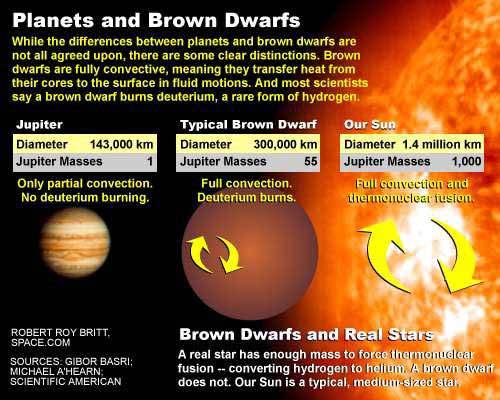What's the Biggest Known Planet?

Editor's Note: This feature article is part ofSPACE.com's weekly Mystery Monday series.
Pluto huggers and haters may hog the spotlight, but there's anotherdebate on the bigger end of the planetary scale. Astronomers have in recentyears uncovered super-massive objects that blur the boundary between planet andfull-blown star.
The complications go beyond simply defining stars as undergoingthermonuclear fusion. Planethunters peering at distant stars have found huge orbiting objects whichdwarf Jupiter, the largest gas giant planet in our solar system. Such finds mayrepresent the missing links on the sliding scale between planets and stars.
"Taken together, thesediscoveries are going to change what we call a planet," said Sara Seager,an astrophysicist at MIT. "Until now people have been arguing about howbig can an object be and still be a planet."
Brown dwarfs represent the largest objects which inhabit that hazy spacebetween planets and stars. They remain smaller than the dimred dwarf stars, but can range in size up to 70 Jupiter masses. Many simplylook like failed stars which never achieved fusion, and yet some colder,smaller brown dwarfs appear more similar to gas giants such as Jupiter orSaturn.
One such browndwarf made headlines in April 2008. The free-floating object has a massbetween 15 and 30 times that of Jupiter, and represents the coolest object ofits type at 660 degrees Fahrenheit (350 Celsius). Astronomers consider it apossible representative of a new class of objects, which forms yet anothermissing link in the overall planetary puzzle.
Going down the scale, the first-everdirect images of extrasolar planets also came late last year. They includedone discovery of a three-planet system where the objects ranged from seven to10 Jupiter masses. Another discovery involved the planet Fomalhaut b with amass of just three Jupiter masses.
Get the Space.com Newsletter
Breaking space news, the latest updates on rocket launches, skywatching events and more!
Such objects fall within the generally accepted upper limit of planetsbeing below 13 Jupiter masses. However, the findings could still helpscientists revise their planetary definitions based on how objects form, ratherthan just mass. Both systems contain dusty disks that reflect their young age,and also seem consistent with how planets likely formed in our solar system andelsewhere.
The existing uncertainty about large-class objects even arose during a Plutodebate held in March 2009 at the American Museum of Natural History in New York City. Seager pointed to the three-planet system as just one example of evolvingscientific knowledge regarding big planets.
"No one is writing alaw or rule that you have to call them this or that," Seager said,referring to the more than 300 extrasolar planets orbiting alien stars.
Perhaps this just means that scientists can take their pick of biggestknown planet, if they get their definitions sorted out. But most likely knowthat ongoing discoveries beyond our solar system could snatch away theheavyweight title at any time.
- Video - Planet-Hunting Kepler Takes Flight
- Video - NASA's Kepler: Hunting Alien Earths
- Top 10 Most Intriguing Extrasolar Planets
Join our Space Forums to keep talking space on the latest missions, night sky and more! And if you have a news tip, correction or comment, let us know at: community@space.com.
Jeremy Hsu is science writer based in New York City whose work has appeared in Scientific American, Discovery Magazine, Backchannel, Wired.com and IEEE Spectrum, among others. He joined the Space.com and Live Science teams in 2010 as a Senior Writer and is currently the Editor-in-Chief of Indicate Media. Jeremy studied history and sociology of science at the University of Pennsylvania, and earned a master's degree in journalism from the NYU Science, Health and Environmental Reporting Program. You can find Jeremy's latest project on Twitter.









